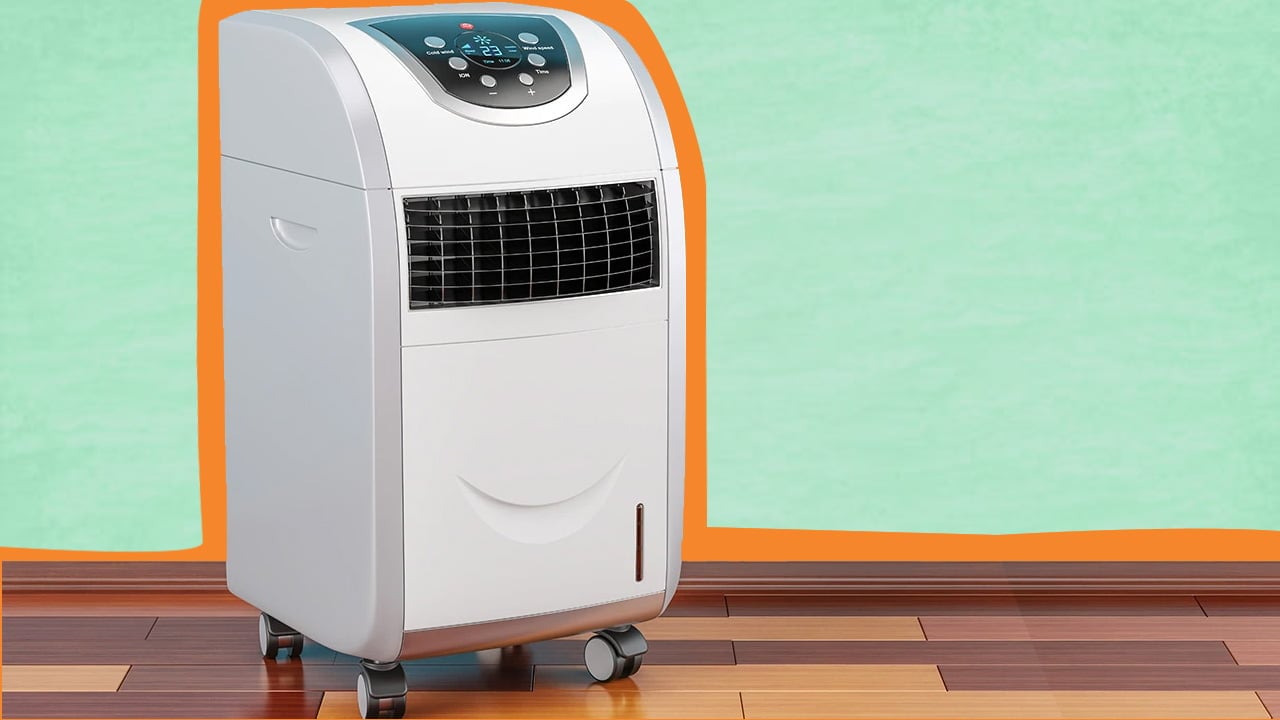The amps or ampere rating of an air conditioner measures the amount of electric current it draws and how much electricity travels through the machine at any given time. The average amp rating for portable ACs is 3.1A to 12.8A

With summers right around the corner, air conditioners are bound to be used quite frequently. However, most homeowners remain unaware of how many amps their cooling system uses. This can lead to problems such as an expensive power bill and, worse, power overload.
So, understanding the amp usage of your machine is necessary, so let's take a look at how many amps a portable air conditioner uses in detail.
Air Conditioner Amperes

Amperes in air conditioners define the amount of electricity that travels from one particular point to another in a given time frame. When a device "draws amps," it generally talks about the amount of electric power needed to run the system.
If the machine draws more amps than necessary, it can result in an overload or a circuit breaker trip. If such is the case, immediately remove the AC from that particular circuit breaker.
How Many Amps Do Portable ACs Use?
On average, portable air conditioners use about 3.1A to 12.8A, with 12A being the most common portable AC amps. By looking at any reliable air conditioner amperage chart, I can derive that the higher the BTU (British Thermal Units), the more the amperage. However, there are a few exceptions to this case.
There are some portable air conditioners with low amps and high BTU (British Thermal Unit) that have become quite popular. An example of this is the Costway Portable Air Conditioner.
Most portable AC units draw amps at a level that falls on the higher side of the scale. After comparing the most popular portable air conditioners on the market, it was found that a majority of portable ACs draw 9A or higher. Similarly, only few portable AC units tend to draw around 6A to 8.9A.
Portable Air Conditioner Amps Considerations
The ampere of a portable air conditioner will be provided by the manufacturer. Ideally, this number would be the maximum amount of amperes that the air conditioner can and should draw when being used.
However, several other factors can heavily influence the number of amps drawn by the air conditioning unit, including the cooling stage, settings, input power supply, and cycle. Generally, portable air conditioners can effortlessly run on basic circuits found in most homes, like 15A and 110V circuits.
These traditional circuits and breakers tend to provide for startup surges. Due to this reason, the ampere of a portable air conditioner is not a significant concern for most American residents that run their device from the mains power or a standard household outlet.
However, for those who run their air conditioning units on generators or batteries, the ampere of a portable AC can be of more concern. If your power system does not efficiently provide for portable air conditioner startup amp surges, it can threaten the device and cause damage.
A common rule of thumb is that startup surges are typically twice or thrice higher than the running amps of an air conditioner. Before you set up your appliance, it is recommended to contact a licensed electrician to gain clarity and run the AC system without any problems or risks.
A. High Amps Portable Air Conditioner
A startup surge does not necessarily happen when the device is turned on for the first time. Most portable air conditioners with components like condensers, compressors, and evaporators tend to cycle through on and off during each functioning period.
When these components keep cycling through on and off, the air conditioner draws in more power than necessary. However, this sudden spike in the number of amps drawn drops significantly once the startup power settles down.
The portable AC unit also tends to draw many low levels of amps, lower than the listed level, when it is not actively cooling your home. To further reduce the overall amperage drawn by the air conditioning unit, you can alter the power settings, increase the temperature settings or change the cooling mode.
For instance, the Eco mode on portable air conditioners is an energy-efficient option that minimizes the number of amps used.
B. Low Amp Portable Air Conditioner
Portable air conditioners with a lower amperage level tend to draw around 3.1A or up to 6A. Approximately, a small percentage of portable air conditioning units that were compared fall under this low ampere category.
An example of a portable air conditioner that draws low amps is the Costway EP24041 air conditioner. But similar to their higher amp counterparts, low amp air conditioners tend to go through startup power surges. This factor, along with a few others, are critical consideration for the amperage of a portable air conditioning system.
How To Calculate The Amps Usage Of An Air Conditioner
To calculate the ampere required to run your air conditioning system, it is necessary to take these factors into consideration.
1. BTU Rating
The BTU (British Thermal Units) rating of an air conditioner determines the amount of heat it can pull out from a room at a given period of time. If the BTU units are higher, it results in a better cooling power of an air conditioning unit, especially in a larger space.
Tip
To identify the BTU rating of your air conditioner, refer to the label attached to the side of the device. Usually, BTU ratings can range anywhere from 5,000 to 28,000 BTU. However, some manufacturers specify the cooling capacity of the device using tons. For better reference, remember that 1 ton equates to 12,000 BTU.
2. EER Rating
EER rating, or the Energy Efficiency Ratio, is an efficiency measure of an air conditioner that uses electricity to cool down a specific space. Generally, the energy efficiency rating of the device is mentioned on the same label as the one where the BTU rating is mentioned. Ideally, the energy efficiency rating of most air conditioners ranges from 13 to 25.
3. Voltage Capacity
Voltage ratings measure the electric current flowing from one particular point to another. The higher the voltage rating, the faster the current moves through the circuit. Based on the model of the AC unit and the size, the average voltage of an air conditioner can range anywhere between 100V and 280V.
To find out the voltage of your air conditioner, refer to the label that is located outside the condensing unit. In case the voltage is not mentioned, it can still be calculated using your air conditioner's BTU rating.
Typically, a 5,000 BTU air conditioner will have a voltage of 120V, whereas average central air conditioners have voltages around 230V.
How To Convert BTU And EER Rating To Wattage
To calculate the wattage of your air conditioning unit, all you have to do is simply divide the BTU rating by the EER rating.
Or to be specific, AC Wattage = BTU/ EER.
For instance, let's take a 15,000 BTU air conditioner along with an EER of 16.
Hence, the wattage would be:
= 15,000/ 16
= 937.5 watts
How To Convert Watts And Volts To Amps
To calculate the amp usage of your air conditioning system, simply divide the unit's wattage by its voltage rating.
In simpler terms, Amps = wattage/ volts
For instance, let's take a 5,000 BTU air conditioner, along with an EER rating of 13 and 120 volts.
As mentioned above, you can find the wattage using the formula: wattage = BTU/ EER
= 5,000/13
= 384.6 watts
Now, to find Amps, I can use the formula:
Amps = wattage/voltage
= 384.6/ 120
= 3.2 amps
If you find calculating the ampere rating by yourself a tedious task, you can easily use an AC amps calculator that is available online on Amazon. Now that you know all about calculating amps for your portable air conditioner let's look at the amperage of other types of air conditioners.
How Many Amps Do Window Air Conditioners Use?
A window air conditioner is generally preferred to cool a small to medium-sized room, with a floor space of up to 550 square feet. On average, a window AC comes with a BTU rating that ranges between 5,000 and 12,000, while the voltage of a window AC ranges between 115V and 220V.
Before using a window AC, it is important to know how many amps the window AC uses. This is because window air conditioners generally consume much higher amps when compared to that other air conditioners or electrical appliances. Based on the BTU capacity of the device, a window air conditioner usually draws anywhere between 4 and 20 amps in the United States.
How Many Amps Does A Central Air Conditioner Use?
A central AC unit is the most commonly found AC type in most residential spaces. These devices come in two different varieties - a full package system comprising a single unit and a split air system with two units located indoors and outdoors.
Central air conditioners are used to cool a larger space or a house with several rooms. Based on the size of the device and the model, a central air conditioner can draw around 15 to 20 amps.

Final Words
Ending up with an air conditioner that does not match the energy requirement of your home and uses more energy is a frustrating experience. This is why knowing how many amps your device uses is essential.
Furthermore, you can have an estimate of the energy consumption as well as the costs you may incur. So, refer to my article to know more about the air conditioner capacity and the amperage rating to make an informed decision for efficient energy use.
